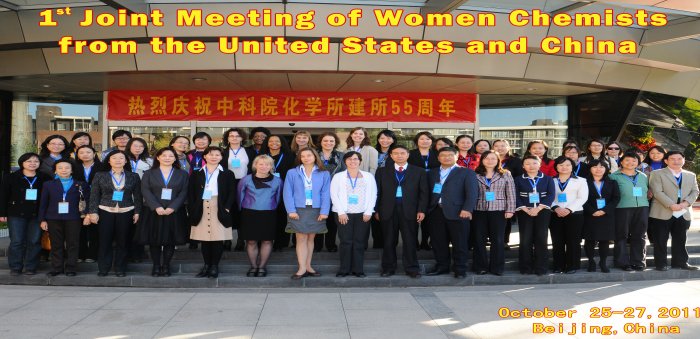EUGENE, Ore. -- (Oct. 31, 2011) -- Women chemists from the United States and China have concluded a historic three-day workshop in Beijing -- a session believed to be the first in China to bring just women together from the two countries to share and discuss their research.
Among the topics discussed were new approaches to drug design and delivery, novel materials for energy storage, biosensors and robotics, and new techniques for use in cancer screening, live-cell imaging and environmental remediation.
The workshop -- sponsored by the U.S. National Science Foundation, the National Natural Science Foundation of China and the University of Oregon COACh program (Committee on the Advancement of women in Chemistry) -- was held at the Institute of Chemistry, Chinese Academy of Sciences. It was timed to coincide with the 100th anniversary of the Nobel Prize in Chemistry awarded to Marie Curie, a French-Polish physicist and chemist. Her Nobel Prize in Chemistry in 1911 recognized her contributions to the study of radioactivity.
"The workshop's agenda allowed for a broad perspective of science that is not always covered in such meetings," said Geri Richmond, professor of chemistry at the University of Oregon and co-organizer of the meeting.
The sessions featured scientific presentations by 10 women chemistry faculty members from each country. Another focal point was a discussion on career opportunities and challenges for female research chemists in the two countries. The event also included poster exhibits of research done by female graduate students, postdoctoral associates and new faculty from Beijing-area universities.
"It was easily the best meeting thus far in my career," said Christy Landes, a professor of chemistry at Rice University in Houston, Texas. "Three days of great talks by colleagues from the U.S. and China have inspired new collaborations. It's great to know the actual investigators when I read a paper from the Chinese Academy of Sciences or from universities in Peking, Fudan or Tsinghau."
Li-Zhu Wu, professor of chemistry at the Technical Institute of Physics and Chemistry in the Chinese Academy of Sciences, echoed this sentiment: "Although I have attended hundreds of meetings, this is my first time to have such a meeting for women. It is quite unique and impressive. As we know, chemistry is so broad. Women chemists both from US and China touch every field of chemistry today. It is an excellent platform for us to share research, to make friends and to have a chance for collaboration."
In his opening remarks at the workshop, Wenping Liang, executive deputy president of chemical sciences at China's National Natural Science Foundation, noted the historic nature of the workshop and the importance of this initial and continuing effort to increase the career development opportunities for women chemists internationally.
As in the U.S., the number of male research directors in chemistry in China is much larger than their female counterparts, he said. By adopting many of the policies and practices put in place in the U.S. as well as developing ones aligned with the Chinese culture, China has been working diligently to increase the numbers and successes of women researchers.
"In many international scientific conferences, the number of women giving invited and plenary talks is very small," said Geri Richmond, who was a co-founder of COACh in 1998. "Without such exposure, women are at a disadvantage when it comes to developing the kind of international recognition that is becoming increasingly important in today's global science."
Representatives from both countries agreed that helping women develop international research collaborations is important for their career advancement. Both Richmond and co-organizer Xiaohong Fang, a professor at the Institute of Chemistry, Chinese Academy of Sciences, see this workshop as a mechanism to increase the international visibility of its women scientists in the two countries while providing an opportunity to form collaborations and friendships among top women chemists in the two countries.
About the University of Oregon
The University of Oregon is among the 108 institutions chosen from 4,633 U.S. universities for top-tier designation of "Very High Research Activity" in the 2010 Carnegie Classification of Institutions of Higher Education. The UO also is one of two Pacific Northwest members of the Association of American Universities.
Media Contact: Jim Barlow, director of science and research communications, 541-346-3481, jebarlow@uoregon.edu
Source: Geraldine "Geri" Richmond, Richard M. and Patricia H. Noyes Professor of Chemistry, 541-346-4635, richmond@uoregon.edu
